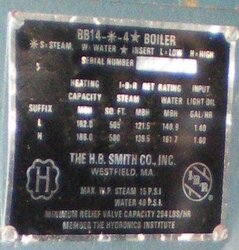Here's my situation. Two family home in Central Maine. Approximately 5,000 sq ft., 2,500 per floor. Two chimney's, one unused the other used by an oil fired tankless boiler located in the full cellar, which is not used for living space. Two single brick unlined chimneys. The chimneys are in the middle of the house and about 20' apart. The unused chimney doesn't have a flue in the basement. The flue opening inside this chimney begins at the first story level of the house. The unused chimney has capacity for one six inch liner but not an eight inch liner when clearance from cumbustibles are taken into consideration. Two zones, two thermostats, baseboard radiant heat. One zone heats up stairs, where people are living and the second zone heats down stairs currently unoccupied but heated to 50 degrees to keep the pipes from freezing. The domestic hot and cold water supply is not seperated, upstair from down stairs. There is no propylene glycol in the radiant system. I believe this is called a two zone, closed, pressurized, hydronic oil-fired system. Correct me if I'm wrong. The house is attached to a two and a half story barn with a dirt floor. The cellar has a dirt floor as well.
My goals is to heat the house independent of fossil fuels with the primary incentive of saving money. One possibility I am considering is to seperate the two floors making them thermally independent with the option of shutting one floor down completely while heating the other with wood, pellets, or other biomas. This would require buying and installing two boilers. I am also considering a water storage tank charged by a high energy short burst boiler. It may be more economical to retain the current plumbing arrangement and install one monster boiler in the barn with an underground hot water transfer storage tank that can hold a charge for 24 hours and requires less attendance. I am open to all suggestions including designer referrals.
What do you recommend?
My goals is to heat the house independent of fossil fuels with the primary incentive of saving money. One possibility I am considering is to seperate the two floors making them thermally independent with the option of shutting one floor down completely while heating the other with wood, pellets, or other biomas. This would require buying and installing two boilers. I am also considering a water storage tank charged by a high energy short burst boiler. It may be more economical to retain the current plumbing arrangement and install one monster boiler in the barn with an underground hot water transfer storage tank that can hold a charge for 24 hours and requires less attendance. I am open to all suggestions including designer referrals.
What do you recommend?


